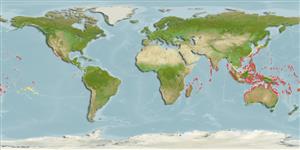>
Blenniiformes (Blennies) >
Tripterygiidae (Triplefin blennies) > Tripterygiinae
Etymology: Enneapterygius: Greek, ennea = nine times + Greek, pterygion = little fin (Ref. 45335).
More on author: Peters.
Environment: milieu / climate zone / depth range / distribution range
Ecologia
marinhas associadas(os) a recifes; intervalo de profundidade 0 - 8 m (Ref. 27223). Tropical
Indo-Pacific.
Tamanho / Peso / Idade
Maturity: Lm ? range ? - ? cm
Max length : 3.0 cm SL macho/indeterminado; (Ref. 27223)
Descrição breve
Chaves de identificação | Morfologia | Morfometria
Espinhos dorsais (total) : 13 - 16; Raios dorsais moles (total) : 8 - 9; Espinhos anais: 1; Raios anais moles: 15 - 17. Pectoral-fin rays15, at least some branched; caudal peduncle without distinctive bar or marking; body without well defined bars; body, head and fins of males densely and evenly covered with melanophores, lower half of head generally darker than upper, in immature males and females less densely covered with melanophores sometimes showing indistinct oblique bars on body and anal fin; supratemporal sensory canal C-shaped, running in a curve in front of the first dorsal-fin spine; single symphysial mandibular pore present; no labial folds.
Adults occur in tide pools; in shallow water on beach rock, brown algae and coralline algae. Apparently associated with coralline rocky shore or reef flat (Ref. 27223). Eggs are hemispherical and covered with numerous sticky threads that anchor them in the algae on the nesting sites (Ref. 240). Larvae are planktonic which occur primarily in shallow, nearshore waters (Ref. 94114).
Life cycle and mating behavior
Maturities | Reprodução | Spawnings | Egg(s) | Fecundities | Larvas
Fricke, R., 1997. Tripterygiid fishes of the western and central Pacific, with descriptions of 15 new species, including an annotated checklist of world Tripterygiidae (Teleostei). Theses Zool. 29:1-607. (Ref. 27223)
Categoria na Lista Vermelha da IUCN (Ref. 130435)
Ameaça para o homem
Harmless
Utilização humana
Ferramentas
Relatórios especiais
Descarregue XML
Fontes da internet
Estimates based on models
Preferred temperature (Ref.
123201): 24.6 - 29.3, mean 28.3 °C (based on 2580 cells).
Phylogenetic diversity index (Ref.
82804): PD
50 = 0.5000 [Uniqueness, from 0.5 = low to 2.0 = high].
Bayesian length-weight: a=0.00562 (0.00258 - 0.01228), b=3.08 (2.89 - 3.27), in cm total length, based on LWR estimates for this (Sub)family-body shape (Ref.
93245).
Nível Trófico (Ref.
69278): 3.1 ±0.3 se; based on size and trophs of closest relatives
Resiliência (Ref.
120179): Elevada, tempo mínimo de duplicação da população menor que 15 meses (Preliminary K or Fecundity.).
Fishing Vulnerability (Ref.
59153): Low vulnerability (10 of 100).
Nutrients (Ref.
124155): Calcium = 634 [211, 3,017] mg/100g; Iron = 2.99 [0.90, 7.48] mg/100g; Protein = 18.2 [16.3, 20.1] %; Omega3 = 0.0937 [, ] g/100g; Selenium = 65.3 [10.1, 327.3] μg/100g; VitaminA = 34 [4, 305] μg/100g; Zinc = 6.76 [2.64, 13.74] mg/100g (wet weight);
